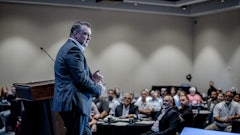
It’s a new era for the Canadian collision repair industry, and one that offers shop owners more paths to growth than ever before. Th e traditional roadmap, opening a single shop and building a loyal customer base through hands-on leadership, still holds value. But it’s clear we’re at a turning point. Th e dynamics have shift ed. For those who can manage a single location profitably and efficiently, the question becomes: why stop at one?
Th e modern business environment makes multi-shop ownership possible, and practical. In today’s network-based ecosystem, management structures and repair processes have been refined to the point where scaling up doesn’t mean doubling the stress. You’re essentially expanding the size of your shop floor—but using the same infrastructure, systems and leadership models you’ve already proven.
Franchise and banner networks have played a significant role in this shift . With structured procedures, centralized support and established vendor relationships, they’ve made growth feel less like a leap and more like a logical next step. In the right hands, with the right systems in place, owning two or three shops can be just as manageable as running one—sometimes even more so, thanks to the benefits of scale.
Another important factor driving this evolution is a fundamental shift in who owns collision centres today. Gone are the days when the typical shop owner was someone who worked their way up from sweeping floors to pulling dents and eventually managing the whole operation. Increasingly, we’re seeing second—and third— generation owners who bring a different kind of expertise—education in finance, management, operations and marketing. They may not have turned a wrench, but they know how to turn a profit.
At the same time, capital investors have started to take a serious interest in the collision sector. Groups are being formed, acquisitions made and portfolios built. Th e thinking is clear: shops that are well-managed, well-equipped and properly staff ed represent sound, long-term investments. Th is influx of capital adds fuel to the fi re, making it easier for those with proven track records to grow quickly—if they choose to.
Of course, not everyone sees these changes as wholly positive. There’s something to be said for the old-school model, where the owner knew every customer by name and could walk an insurance appraiser through a repair plan with authority. Th at model fostered a sense of trust, accountability and hands-on leadership. But it’s increasingly rare.
Today’s reality is shaped by technology. With desk estimating and AI-based appraisal soft ware, many of those traditional conversations no longer take place face-to-face. Third-party vendors using imaging tools and repair databases now guide much of the process. While this streamlines workflow, it also shift s the skillset required for ownership—from technical to managerial.
Layered on top of this are new challenges: regulatory pressures for sustainability, rising repair complexity and the ongoing difficulty of recruiting and retaining skilled technicians as baby boomers retire. Th e industry is juggling a lot, and yet—true to form—it keeps adapting.
That’s what makes the Canadian collision repair sector so remarkable. When confronted with challenges, we don’t just react—we respond. We innovate, restructure and move forward. It’s not always easy, and it’s certainly not always fast. But this industry has never been afraid of hard work, and it has never lacked the creativity to find a solution.
So if you’re a shop owner who’s built something successful, maybe it’s time to consider taking that next step. Growth isn’t just for the giants anymore—it’s for anyone who’s proven they can lead with purpose, integrity and efficiency. Enjoy your summer. And while you’re at it, take a chance on some students. They might just be the future of your next shop.






















